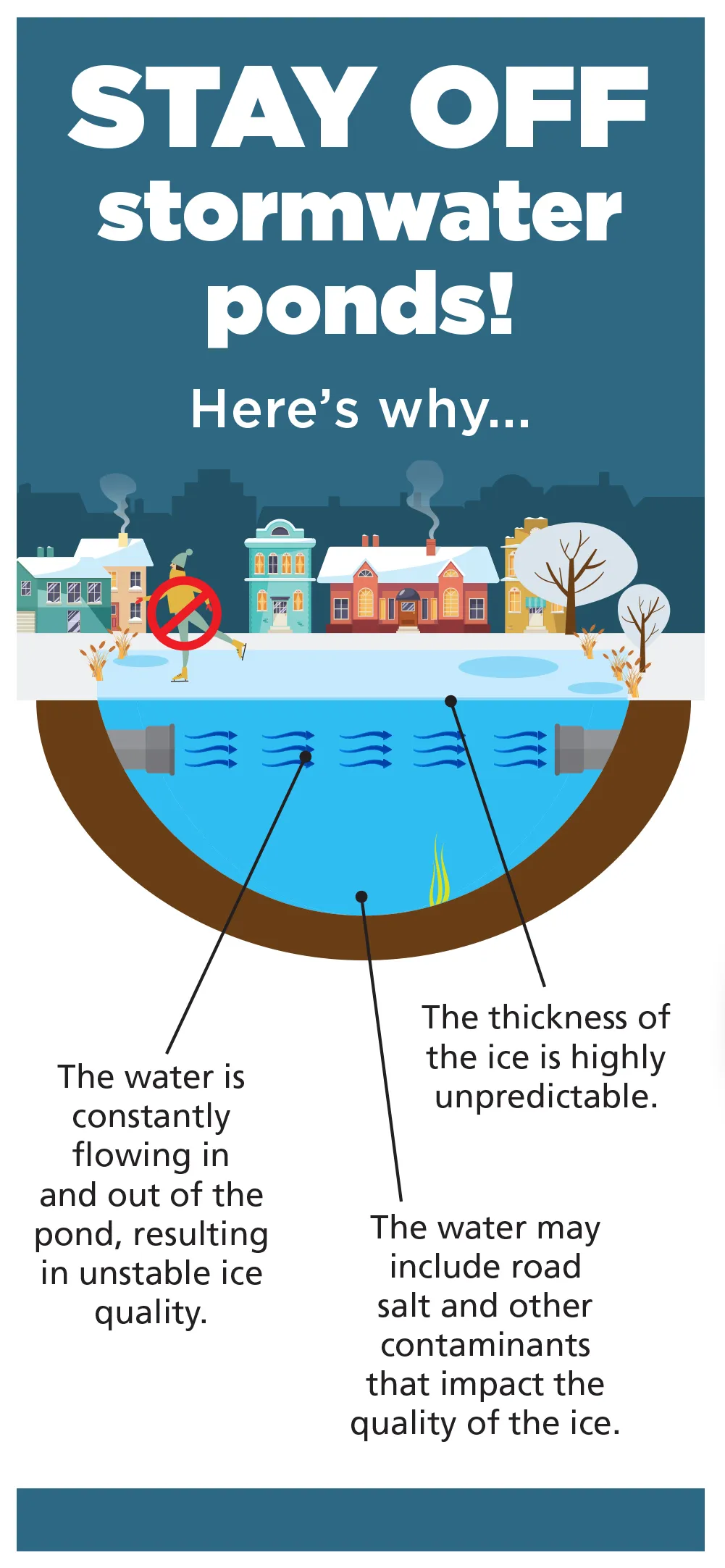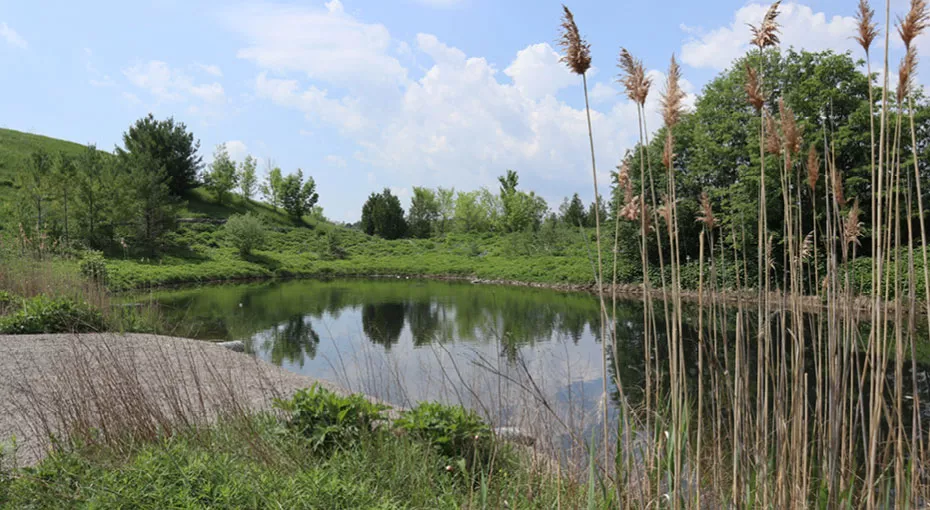Stormwater Management Ponds
The City of Vaughan operates and maintains more than 150 stormwater management ponds, which are designed and built to collect rainfall and other runoff.
About stormwater management ponds
After rain or snowfall, the water left behind on roads, sidewalks, grass and pathways is called “stormwater.” In natural areas, this water is ordinarily absorbed into the ground by plants and soil. However, pavement and other hard surfaces – such as driveways, sidewalks and roofs – prevent this absorption, leading to water pooling or flooding.
To help manage stormwater and reduce flooding, the City operates and maintains stormwater management ponds throughout Vaughan. These are designed ponds that gather and retain rainfall and surface water runoff. The ponds are typically found in neighbourhoods where stormwater can easily be collected. The City manages more than 150 stormwater ponds.
Stormwater ponds can be either wet or dry and are designed to temporarily hold water before releasing it slowly back into the environment at a controlled rate.
A dry pond remains dry until a rain event, which may result in the temporary retention of stormwater.
A wet pond holds water all the time and collects and stores runoff from rain and melted snow. Wet ponds collect sediment so only clean water is released back into rivers, creeks and lakes.
The following activities are not permitted within the City’s stormwater pond properties:
Planting gardens or cutting grass on pond property.
Storing yard materials on pond property.
Installing gates to access pond property from fenced yards.
Disposing of grass clippings, yard waste or garbage on pond property or into a pond.
Disturbing plants and vegetation around a pond.
Disposing of pet fish in a pond.
Disposing of swimming pool water and chemicals down a catch basin, on pond property or in a pond.
Reporting an issue
Notice a stormwater pond that requires attention? Report issues, including any odours, beaver activity (damming) or high water levels, to Service Vaughan online at 905-832-2281 or service@vaughan.ca.
Littering and illegal dumping are prohibited under the City’s Dumping By-law 103-2020 (PDF). If you witness either of these actions at a stormwater pond, please report it to Service Vaughan at 905-832-2281 or service@vaughan.ca.
Have you noticed a visible sheen or film on the surface of a pond or abnormal water colour in it? This may be a sign of an environmental spill. If you see this, immediately notify the City at 905-832-2281. When reporting, please provide as much information as possible, such as the exact location or nearest address, what it is or looks like, if you saw how the spill happened and how long it may have been there.
Frequently Asked Questions
-
Answer
Stormwater ponds help manage excess rain and melted snow by collecting water from the storm sewer system. Each pond has at least one inlet that allows water to flow from the storm sewer system into the pond. Once the stormwater drains into the stormwater pond, any sand, dirt and other sediment settle at the bottom of the pond, naturally filtering the water. The pond's outlet then releases water into a nearby creek system at a controlled rate, helping to prevent flooding and improve water quality.
The water in stormwater ponds is not treated at a treatment plant before re-entering the environment; therefore, everyone must do their part to keep it clean by ensuring only rain or snow goes down the drain.
-
Answer
Stormwater ponds have many benefits, including:
- reducing flooding on streets and in greenspaces.
- protecting the natural environment from erosion.
- protecting rivers, creeks and lakes by trapping pollutants such as oil, pesticides, bacteria and trash, and excessive nutrients (such as phosphorus and nitrogen), which can lead to algal blooms.
- creating a habitat for wildlife.
-
Answer
No. Stormwater ponds may look safe to walk and skate on, but they are not. They are dangerous due to water constantly flowing in and out of the pond underneath. These ever-changing water levels make the thickness of the ice highly unstable and unpredictable, which is a safety hazard. Please keep off the ice.
If you’re looking for a safe place to skate in Vaughan, visit one of the City’s outdoor skating rinks. For details, visit vaughan.ca/skate.
Image
-
Answer
No. These ponds may look safe for fishing, swimming or playing around, but they are not made for recreational use. Keep a safe distance away. The ponds temporarily hold water before releasing it slowly back into the environment at a controlled rate. This process means water constantly flows in and out of the pond, so water levels are always changing. This makes any activity in or around the pond unsafe. Additionally, the bottom of a stormwater pond is often very soft, which can cause people or pets to become stuck if they enter.
If you’re looking for a safe place to swim and play, visit vaughan.ca/swim or vaughan.ca/splashpads for a list of locations in Vaughan.
-
Answer
The City manages and maintains more than 150 stormwater ponds in Vaughan. Year-round, routine maintenance includes removing debris in and around the pond that may impede water flow, such as removing invasive vegetation, and maintaining structures, such as inlets and outlets. Additionally, from May to October, three rounds of litter pickup and grass cutting are completed at each pond to ensure staff can access the pond for operational purposes.
-
Answer
The vegetation growing around stormwater ponds, such as long grass, shrubs and trees, is integral to how the ponds function. This is because they:
- act as safety barriers for pedestrians.
- discourage geese from landing in the ponds.
- improve water quality.
- filter out coarse sediments (like sand or gravel) and pollutants from the water.
- stabilize the ground when water levels fluctuate.
-
Answer
Algae in stormwater ponds, especially in the summer, is not always a sign that a pond is unhealthy. It’s a natural response to nutrients (such as phosphorus and nitrogen) being carried into the water through stormwater runoff from nearby lawns, gardens and roads. When it rains, pollutants – nutrients, fertilizers, pet waste, yard waste, dirt and more – from lawns, gardens and roads can wash into stormwater ponds. This can cause algae to form.
Algae may benefit a stormwater pond’s ecosystem by converting sunlight and nutrients into energy, providing food for organisms. A certain level of algae is expected and even valuable for a pond's overall health. However, too many nutrients become pollutants, which can be unhealthy for the pond and the surrounding environment.
You can help reduce the number of pollutants entering stormwater ponds by:
- reducing fertilizer use or using phosphorus-free fertilizers.
- disposing of yard waste and grass clippings properly to prevent them from entering the City’s stormwater system via catch basins in the road.
- cleaning up pet waste to prevent it from washing into the stormwater system.
-
Answer
Summer’s warm temperatures and periods of rain are perfect growing conditions for algae and floating aquatic plants. Floating aquatics plants, such as duckweed and watermeal, may be mistaken for algae but provide some benefits for ponds if they only cover approximately 30 per cent or less of the pond’s surface.
These benefits include:
- providing shade and cooler water temperatures.
- absorbing nutrients, which reduce algae growth.

